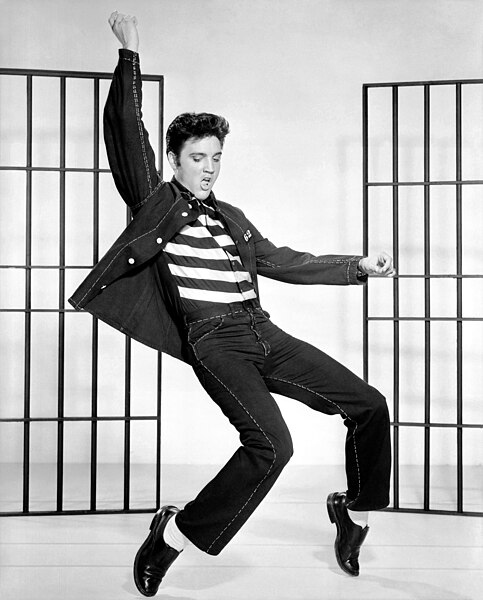File:Elvis Presley Jailhouse Rock.jpg

File originale (1 772 × 2 200 pixel, dimensione del file: 842 KB, tipo MIME: image/jpeg)
Questo file proviene da Wikimedia Commons e può essere utilizzato da altri progetti. Di seguito viene mostrata la descrizione presente nella pagina di descrizione del file.
Dettagli
| DescrizioneElvis Presley Jailhouse Rock.jpg |
English: A photograph promoting the film w:Jailhouse Rock depicts singer Elvis Presley. |
| Data | |
| Fonte | http://www.doctormacro.com/Images/Presley,%20Elvis/Annex/Annex%20-%20Presley,%20Elvis%20(Jailhouse%20Rock)_01.jpg |
| Autore | Metro-Goldwyn-Mayer, Inc. |
| Licenza (Riusare questo file) |
PD-PRE1964; PD-US-NOT RENEWED. |
Licenza
| Public domainPublic domainfalsefalse |
Quest'opera è nel pubblico dominio in quanto pubblicata negli Stati uniti tra il 1929 e il 1963 con un avviso di copyright, ma il copyright non è stato poi rinnovato. A meno che l'autore non sia deceduto da diversi anni, è protetta da copyright nei Paesi o nelle aree in cui non si applica la regola della durata più breve per le opere statunitensi, come Canada (50 pma), Cina (50 pma, non Hong Kong o Macao), Germania (70 pma), Messico (100 pma), Svizzera (70 pma) e altri Paesi con trattati individuali. Vedi Commons:Hirtle chart per ulteriori approfondimenti.
العربية ∙ Deutsch ∙ English ∙ español ∙ français ∙ galego ∙ italiano ∙ 日本語 ∙ 한국어 ∙ македонски ∙ português ∙ português do Brasil ∙ русский ∙ sicilianu ∙ slovenščina ∙ українська ∙ 简体中文 ∙ 繁體中文 ∙ +/− |
Copyright details
Additional source information:
This is a publicity photo taken to promote a film actor. As stated by film production expert Eve Light Honthaner in The Complete Film Production Handbook, (Focal Press, 2001 p. 211.):
- "Publicity photos have traditionally not been copyrighted. Since they are disseminated to the public, they are generally considered public domain, and therefore clearance by the studio that produced them is not necessary."[1]
Creative Clearance offers similar advice for older publicity stills but distinguishes "Publicity Photos (star headshots)" from "Production Stills (photos taken on the set of the film or TV show during the shooting)". It says newer publicity stills may contain a copyright, and production stills "must be cleared with the studio."[2]
Nancy Wolff, includes a similar explanation:
Legal expert on the use of photographic images, Nancy Wolff, includes a similar explanation:
- There is a vast body of photographs, including but not limited to publicity stills, that have no notice as to who may have created them. . .(The Professional Photographer's Legal Handbook By Nancy E. Wolff, Allworth Communications, 2007, p. 55.)
These photographs came from a photo archive of entertainment industry publicity pictures, historic still images widely distributed by the studios to advertise and promote their then new releases. While not considered valuable at the time, avid collectors have created complete archives by salvaging and cataloging movie and television photographs, preserving a significant facet of American culture. These archives are a valuable cache for publishers who rely on these archives as a resource for entertainment material."[3]
Film industry author Gerald Mast, in Film Study and the Copyright Law (1989) p. 87, writes:
Film industry expert Gerald Mast explains how the new 1989 copyright revisions only protected publicity works that complied with all earlier requirements in addition to filing a copyright registration within 5 years of first publication:
- "According to the old copyright act, such production stills were not automatically copyrighted as part of the film and required separate copyrights as photographic stills. The new copyright act similarly excludes the production still from automatic copyright but gives the film's copyright owner a five-year period in which to copyright the stills. Most studios have never bothered to copyright these stills because they were happy to see them pass into the public domain, to be used by as many people in as many publications as possible."[4]
Kristin Thompson, committee chairperson of the Society for Cinema and Media Studies writes in the conclusion of a 1993 conference with cinema scholars and editors, that they "expressed the opinion that it is not necessary for authors to request permission to reproduce frame enlargements. . . [and] some trade presses that publish educational and scholarly film books also take the position that permission is not necessary for reproducing frame enlargements and publicity photographs."[5]
References
- ↑ Honathaner, Eve Light. The Complete Film Production Handbook, Focal Press, (2001) p. 211
- ↑ Creative Clearance. Photography Clearance. Clearance Guidelines for Producers. Archived from the original on 2013-02-12. Retrieved on 4 May 2011.
- ↑ Wolff, Nancy E. The Professional Photographer's Legal Handbook, Allworth Communications, 2007 p. 55
- ↑ Mast, Gerald. "Film Study and the Copyright Law", from Cinema Journal, Winter 2007, pp. 120-127
- ↑ Thompson, Kristin. [1] "Report of the Ad Hoc Committee of the Society For Cinema Studies, "Fair Usage Publication of Film Stills" "Society for Cinema and Media Studies", 1993 conference
Didascalie
Elementi ritratti in questo file
raffigura
Cronologia del file
Fare clic su un gruppo data/ora per vedere il file come si presentava nel momento indicato.
| Data/Ora | Miniatura | Dimensioni | Utente | Commento | |
|---|---|---|---|---|---|
| attuale | 21:39, 5 giu 2023 |  | 1 772 × 2 200 (842 KB) | Hohum | Greyscale |
Utilizzo del file
La seguente pagina usa questo file:
Metadati
Questo file contiene informazioni aggiuntive, probabilmente aggiunte dalla fotocamera o dallo scanner usati per crearlo o digitalizzarlo. Se il file è stato modificato, alcuni dettagli potrebbero non corrispondere alla realtà.
| Orientamento | Normale |
|---|---|
| Risoluzione orizzontale | 300 punti per pollice (dpi) |
| Risoluzione verticale | 300 punti per pollice (dpi) |
| Software | GIMP 2.10.34 |
| Data e ora di modifica del file | 20:38, 5 giu 2023 |
| Spazio dei colori | sRGB |
| ID univoco del documento originale | xmp.did:a031846a-988d-441d-9ec7-9b7fe79eff3f |
